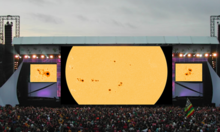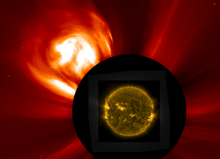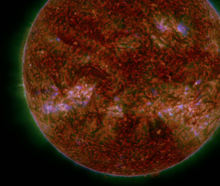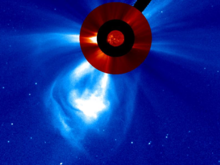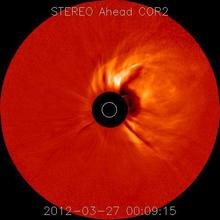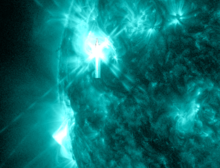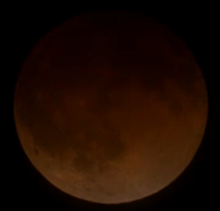news
Submitted on 2014-07-07
Coinciding with the traditional summer festivals, the Sun started a party on its own by producing a flurry of relatively large and complex sunspot groups. While on 29 June, the daily sunspot number was only 62, by 5 July it was at an estimated 152. The 10.7cm radio flux happily joined the festivities, by rising over the same time period from 126 to 193 solar flux units.
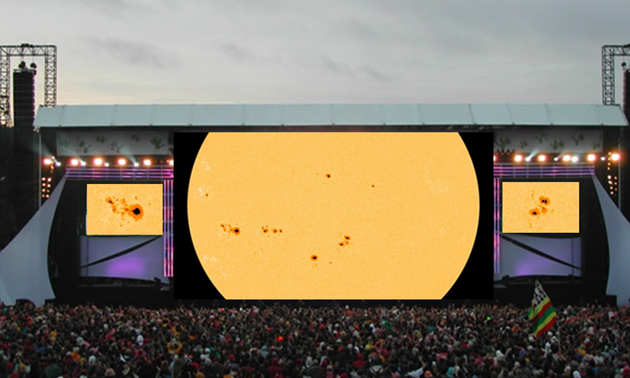
Submitted on 2014-07-02
Late on 26 June, an eruption took place in an active region just behind the Sun's east limb. The event led to some spectacular images of the associated coronal mass ejection (CME) and post-flare coronal loops.
The eruption started around 21:00UT, and the expanding CME can be seen in extreme ultraviolet (EUV) in SDO, STEREO-B and PROBA2 imagery, as indicated with the dashed orange lines in the images underneath.

Submitted on 2014-06-25
Solar filaments are clouds of ionized gas above the solar surface squeezed between magnetic regions of opposite polarity. Being cooler and denser than the surrounding plasma, they appear as dark lines when seen on the solar disk using special filters. On 19 June, a filament north of sunspot region NOAA 2093 became unstable and swirled away from the Sun.

Submitted on 2014-06-18
On 10 and 11 June, the not so big but complex sunspot group NOAA 2087 produced three X-class flares in less than 24 hours. On 10 June, there was an X2.2 peaking at 11:42UT, followed by an X1.5 at 11:52UT. On 11 June, an X1.0 peaked at 09:06UT. This brings the X-class flare counter for the current solar cycle to 34. The associated coronal mass ejections (CME) were not directed to Earth, though from the second CME a glancing blow was expected. In the end, no obvious CME-signature was observed in the solar wind data.
Submitted on 2014-06-13
Solar filaments are clouds of ionized gas above the solar surface squeezed between magnetic regions of opposite polarity. Being cooler and denser than the surrounding plasma, they appear as dark lines when seen on the solar disk using special filters. At the solar limb, the same features shine bright and are called prominences.

Submitted on 2014-06-04
Launched on 25 October 2006, STEREO (Solar TErrestrial RElations Observatory) consists actually of two nearly identical spacecraft. One of the spacecraft is ahead of Earth in its orbit (STEREO-A), the other trailing behind (STEREO-B), and both are at distances from the Sun similar to Earth's.
Submitted on 2014-05-19
From 5 till 18 May, sunspot Group NOAA 2056 made its transit over the solar disk. This group was not especially big, but initially had a complex trailing sunspot section that resulted in an M5 flare on 8 May (see previous Newsletter). Over the next few days, the group gradually simplified and almost completely disintegrated.
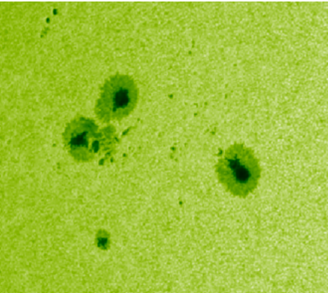
Submitted on 2014-05-14
On 8 May, an M5 flare took place in sunspot region NOAA 2056. This active region was part of a cluster of sunspot groups that had appeared from behind the Sun's east limb between 4 and 6 May.
A movie of the event can be seen here.
Submitted on 2014-05-07
On 15 April, a total lunar eclipse was visible from the America's and the Pacific. Some websites were buzzing about the "Blood Moon", as if werewolves and witches were going to team up and unleash a veritable apocalypse upon us. Fortunately, reality was a lot less dreadful and a lot more beautiful.

Submitted on 2014-04-30
Simultaneous flares are unrelated solar flares in different active regions that occur at nearly the same time. If the flares coincide in time not by chance, but by the triggering of some physical connection, they are called sympathetic flares. More loosely, a sympathetic flare can also be defined as the initiation of a solar flare resulting from a transient phenomenon occurring elsewhere on the Sun. Hence, sympathetic flares are a subset of simultaneous flares.
Pages
Zircon - This is a contributing Drupal Theme
Design by
WeebPal.


